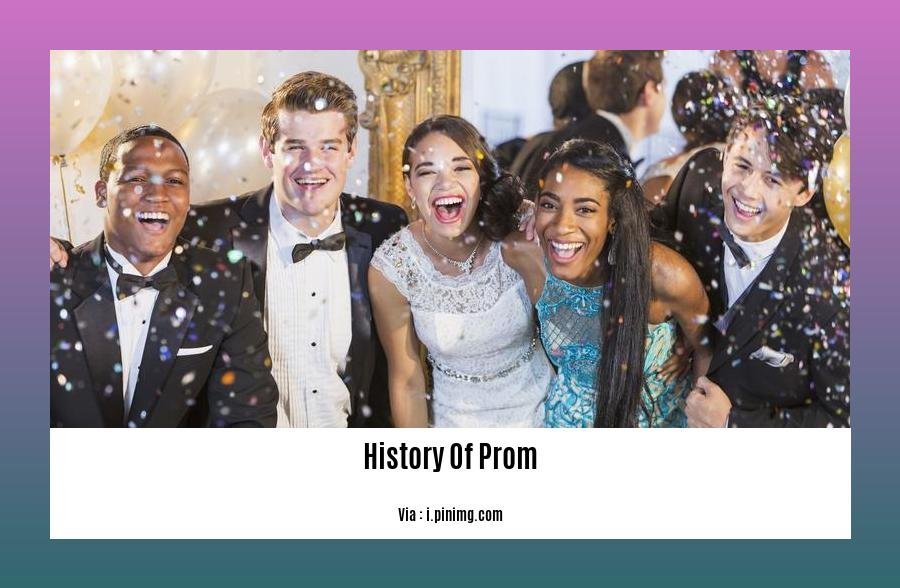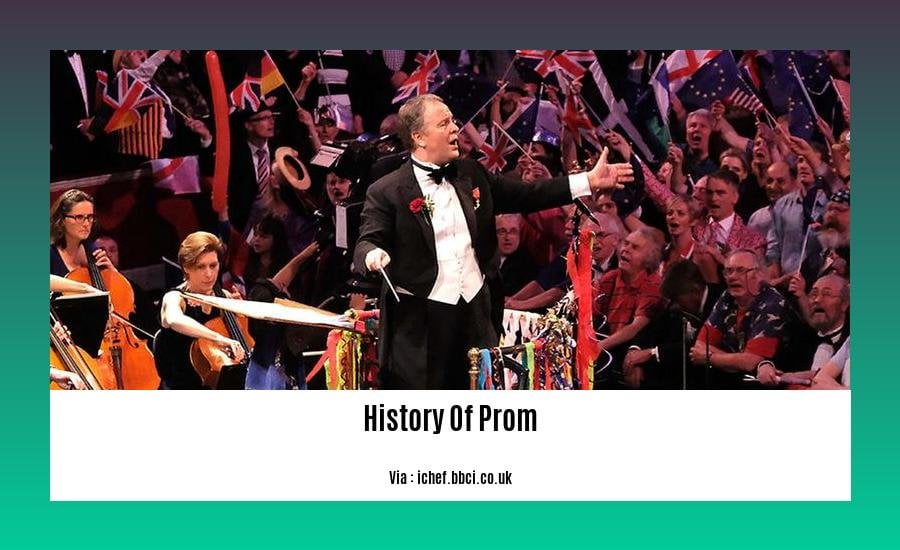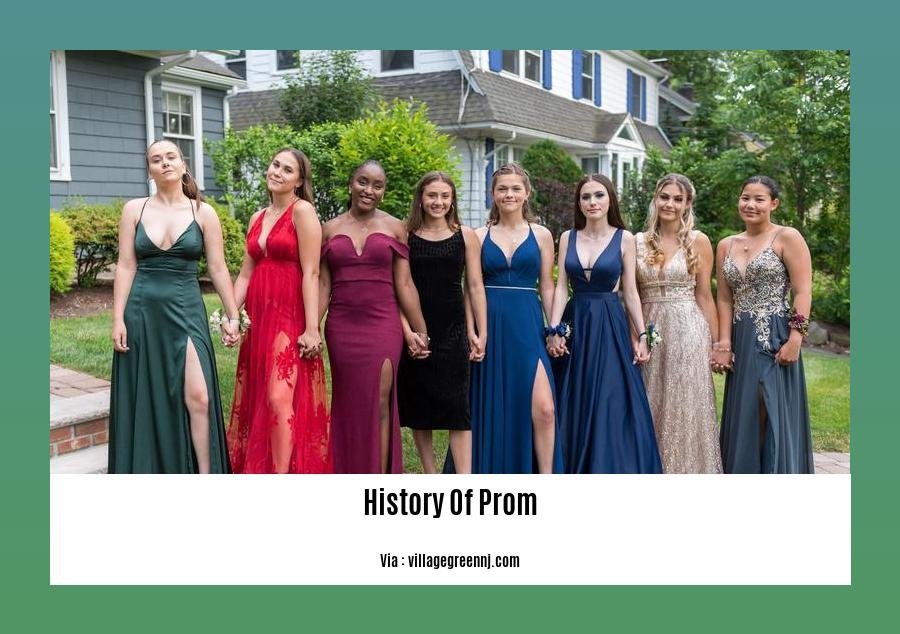Step back in time and explore the fascinating history of prom, a cherished tradition that has captivated generations. From its humble beginnings in the 1920s, prom has evolved into a globally recognized milestone, symbolizing青春の喜びと大いに楽しみます. Join us as we delve into the captivating journey of prom, tracing its origins, cultural shifts, and lasting legacy in America. [- Exploring the History of Prom: Its Enduring Legacy and Cultural Evolution].
Key Takeaways:
Originated in the 19th century as a formal ball for university graduates.
Gained popularity among younger people and high schools in the early 1900s.
Currently, it is a formal dance event for high school seniors in America.
History of Prom: Tracing Its Enduring Legacy and Cultural Evolution


In the annals of American teenage traditions, prom stands tall as a defining moment, a grand celebration that marks the passage from adolescence to adulthood. Its history is a captivating tale of evolving norms, societal shifts, and the enduring allure of youthful exuberance.
Early Roots: The Ivy League Soirees
The history of prom can be traced back to the 19th century, when Ivy League universities initiated formal balls for their graduating classes. These extravagant events, steeped in tradition and elegance, were a showcase of social grace and sophistication.
The Transformation: Prom Goes to High School
As the 20th century dawned, the allure of prom began to extend beyond the hallowed halls of academia. By the 1920s, the tradition had taken root in high schools, initially as a way to celebrate academic achievement and foster camaraderie among seniors.
Post-War Boom: Prom Ascends to Cultural Icon
In the aftermath of World War II, prom experienced a meteoric rise in popularity, mirroring the burgeoning affluence and optimism that characterized the era. It became a cultural touchstone, immortalized in movies, music, and television, and deeply embedded in the American psyche.
Evolution of Prom Traditions
Over the decades, prom has undergone a series of transformations, reflecting changing social norms and cultural trends.
Attire: Initially characterized by formal attire, prom fashion has evolved to encompass a diverse range of styles, from classic tuxedos and ball gowns to more contemporary and eclectic choices.
Music: The musical landscape of prom has also undergone a sea change, from the dulcet tones of big bands to the energetic beats of modern pop and hip-hop.
Themes: Prom themes have emerged as a creative outlet for students, ranging from whimsical to elaborate, adding an extra layer of excitement and anticipation to the event.
Inclusivity: In recent years, there has been a growing emphasis on inclusivity at prom, with schools striving to create a welcoming environment for all students, regardless of sexual orientation, gender identity, or physical ability.
Prom Today: A Celebration of Diversity and Expression
In contemporary America, prom stands as a symbol of diversity and self-expression. It is a night when teenagers from all walks of life come together to celebrate their individuality, forge lasting memories, and commemorate the culmination of their high school journey.
The Enduring Legacy of Prom
The history of prom is a testament to its enduring legacy as a defining moment in the lives of American teenagers. It is an event that has evolved with the times, adapting to changing societal norms while retaining its essence as a celebration of youth, friendship, and the promise of the future.
Explore the fascinating history of promise rings and their evolving significance in various cultures and traditions through the ages. history of promise rings
Did you know that the history of pharmacopoeia in pharmaceutical inorganic chemistry dates back to the ancient civilizations of Mesopotamia and Egypt? Delve into the intriguing journey of this essential reference guide. history of pharmacopoeia in pharmaceutical inorganic chemistry
The 1920s: The Introduction of Proms in High Schools
During the roaring Twenties, when jazz music filled the air, flappers danced into the night, and prohibition ruled speakeasies, a new tradition emerged in American high schools: the prom. Let’s take a stroll down memory lane and explore how proms evolved from co-ed banquets to the grand spectacles they are today.
Key Takeaways:
Proms trace their roots back to ancient Greece, where elite men held formal banquets called “symposia.”
In the United States, proms originated in the 19th century as co-ed banquets held by universities for graduating classes.
The 1920s marked a turning point as proms began transitioning to high schools, becoming more casual and inclusive events for teenage boys and girls on the brink of graduation.
Despite their popularity, early proms were often racially exclusive, excluding Black students from participating in these milestone events.
Over time, proms evolved from simple co-ed banquets to lavish events with formal dresses, hotel ballrooms, and party buses, reflecting the changing social customs and economic prosperity of the era.
In the 1920s, proms symbolized more than just a dance. They were seen as a way to teach students how to behave as respectable men and women along gender and racial lines. However, this seemingly progressive tradition was marred by racial exclusion, as Black students were often denied the opportunity to participate in these milestone events.
As proms gained popularity, they underwent a transformation, evolving from simple co-ed banquets to lavish events held in grand hotel ballrooms. Formal dresses became the norm, and party buses emerged as a popular mode of transportation, adding to the excitement and glamour of the occasion.
Sources:
FAQ
Q1: When did proms begin in American high schools?
A1: Proms started appearing in some American high schools in the early 1900s, gaining popularity among younger people.
Q2: What was the initial purpose of proms?
A2: Proms originated as formal balls held by universities in the 19th century to honor graduating classes.
Q3: Why were proms initially exclusive to white high schools in the 1920s?
A3: In the 1920s, white high schools used proms as a means to teach students gender and racial etiquette, intentionally excluding Black students from participating.
Q4: How did prom traditions evolve over time?
A4: Proms transformed from simple co-ed banquets to elaborate events featuring formal dresses, hotel ballrooms, and party buses.
Q5: What factors contributed to the widespread popularity of proms in American high schools?
A5: Proms became popular in American high schools as they offered a unique opportunity for teenage boys and girls to celebrate their graduation and engage in social activities.
- China II Review: Delicious Food & Speedy Service - April 17, 2025
- Understand Virginia’s Flag: History & Debate - April 17, 2025
- Explore Long Island’s Map: Unique Regions & Insights - April 17, 2025





![[Phrase Match] Embracing Evolution: A Journey Through Contemporary Dance History contemporary-dance-history_2](https://www.lolaapp.com/wp-content/uploads/2023/12/contemporary-dance-history_2-150x150.jpg)










